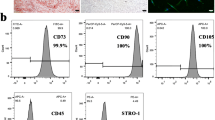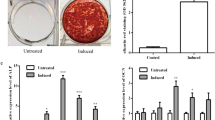Abstract
Periodontal ligament stem cells (PDLSCs) plays an important role in tissue engineering. As the age increased, the cell viability and osteogenic differentiation of PDLSCs all decreased. Low density lipoprotein receptor related protein 5 (LRP5) was found to promote bone marrow mesenchymal stem cells osteogenic differentiation. Therefore, our study explored the effect of LRP5 on normal and aged PDLSCs and relative mechanism. Here, we found that the expression of LRP5 in PDLSCs of 24 week-old mice was decreased compared with PDLSCs of 5 week-old mice (n = 5). . LRP5 overexpression in PDLSCs increased the intensity of alkaline phosphatase and alizarin red staining, accompanied with upregulated the levels of RUNX family transcription factor 2, collagen type I, and β-Catenin. LRP5 knockdown displayed the opposite results in PDLSCs in vitro. LRP5 overexpression in aged PDLSCs restored part ability of osteogenic differentiation. Meantime, LRP5 increased the protein expression of phosphorylation of mammalian target of rapamycin (p-mTOR) in normal and aged PDLSCs. Immunofluorescence showed that LRP5 increased the accumulation of p-mTOR nucleus. The effect of LRP5 in promoting osteogenic differentiation of PDLSCs can be antagonized by mTOR inhibitor rapamycin. These findings suggest that LRP5 positively regulate osteogenic differentiation of normal and aged PDLSCs and may be a potential target for enlarging the application of PDLSCs in tissue regeneration.






Similar content being viewed by others
Abbreviations
- LRP5:
-
Low density lipoprotein receptor related protein 5
- BMSCs:
-
Bone marrow mesenchymal stem cells
- PDLSCs:
-
Periodontal ligament stem cells
- α-MEM:
-
Alpha Modification Minimum Essential Medium Eagle
- FBS:
-
Fetal bovine serum
- SDS-PAGE:
-
Sodium dodecyl sulphate-polyacrylamide gel electrophoresis
- ALP:
-
Alkaline phosphatase
- RUNX2:
-
RUNX family transcription factor 2
- mTOR:
-
Mammalian target of rapamycin
- ARS:
-
Alizarin red staining
- COL1:
-
Collagen type I
- GAPDH:
-
Glyceraldehyde-3-phosphate dehydrogenase
- HRP:
-
Horseradish peroxidase
- EDTA:
-
Ethylenediaminetetraacetic acid
- TBST:
-
Tris-buffered saline containing 0.1% Tween-20
- ODM:
-
Osteogenic differentiation medium
References
Abuarqoub DA, Aslam N, Barham RB, Ababneh NA, Shahin DA, Al-Oweidi AA, Jafar HD, Al-Salihi MA, Awidi AS (2019) The effect of platelet lysate in culture of PDLSCs: an in vitro comparative study. PeerJ 7:e7465. https://doi.org/10.7717/peerj.7465
Ahmed AS, Sheng MH, Wasnik S, Baylink DJ, Lau KW (2017) Effect of aging on stem cells. World J Exp Med 7(1):1–10. https://doi.org/10.5493/wjem.v7.i1.1
Amghar-Maach S, Gay-Escoda C, Sánchez-Garcés M (2019) Regeneration of periodontal bone defects with dental pulp stem cells grafting: systematic review. J Clin Exp Dent 11(4):e373–e381. https://doi.org/10.4317/jced.55574
Brack AS, Conboy MJ, Roy S, Lee M, Kuo CJ, Keller C, Rando TA (2007) Increased Wnt signaling during aging alters muscle stem cell fate and increases fibrosis. Science 317(5839):807–810. https://doi.org/10.1126/science.1144090
Castilho RM, Squarize CH, Chodosh LA, Williams BO, Gutkind JS (2009) mTOR mediates Wnt-induced epidermal stem cell exhaustion and aging. Cell Stem Cell 5(3):279–289. https://doi.org/10.1016/j.stem.2009.06.017
Ching HS, Luddin N, Rahman IA, Ponnuraj KT (2017) Expression of odontogenic and osteogenic markers in DPSCs and SHED: a review. Curr Stem Cell Res Ther 12(1):71–79. https://doi.org/10.2174/1574888x11666160815095733
Chiricosta L, Silvestro S, Pizzicannella J, Diomede F, Bramanti P, Trubiani O, Mazzon E (2019) Transcriptomic analysis of stem cells treated with moringin or cannabidiol: analogies and differences in inflammation pathways. Int J Mol Sci. https://doi.org/10.3390/ijms20236039
Demarco FF, Conde MC, Cavalcanti BN, Casagrande L, Sakai VT, Nör JE (2011) Dental pulp tissue engineering. Braz Dent J 22(1):3–13. https://doi.org/10.1590/s0103-64402011000100001
Esen E, Chen J, Karner CM, Okunade AL, Patterson BW, Long F (2013) WNT-LRP5 signaling induces Warburg effect through mTORC2 activation during osteoblast differentiation. Cell Metab 17(5):745–755. https://doi.org/10.1016/j.cmet.2013.03.017
Feng X, Huang D, Lu X, Feng G, Xing J, Lu J, Xu K, Xia W, Meng Y, Tao T, Li L, Gu Z (2014) Insulin-like growth factor 1 can promote proliferation and osteogenic differentiation of human dental pulp stem cells via mTOR pathway. Dev Growth Differ 56(9):615–624. https://doi.org/10.1111/dgd.12179
Gharibi B, Hughes FJ (2012) Effects of medium supplements on proliferation, differentiation potential, and in vitro expansion of mesenchymal stem cells. Stem Cells Transl Med 1(11):771–782. https://doi.org/10.5966/sctm.2010-0031
Han NY, Hong JY, Park JM, Shin C, Lee S, Lee H, Yun JH (2019) Label-free quantitative proteomic analysis of human periodontal ligament stem cells by high-resolution mass spectrometry. J Periodontal Res 54(1):53–62. https://doi.org/10.1111/jre.12604
Jiang Z, Wang H, Yu K, Feng Y, Wang Y, Huang T, Lai K, Xi Y, Yang G (2017) Light-controlled BMSC sheet-implant complexes with improved osteogenesis via an LRP5/β-Catenin/Runx2 regulatory loop. ACS Appl Mater Interfaces 9(40):34674–34686. https://doi.org/10.1021/acsami.7b10184
Jiang Z, Yu K, Feng Y, Zhang L, Yang G (2020) An effective light activated TiO2 nanodot platform for gene delivery within cell sheets to enhance osseointegration. Chem Eng J 402:126170. https://doi.org/10.1016/j.cej.2020.126170
Kim SH, Kim KH, Seo BM, Koo KT, Kim TI, Seol YJ, Ku Y, Rhyu IC, Chung CP, Lee YM (2009) Alveolar bone regeneration by transplantation of periodontal ligament stem cells and bone marrow stem cells in a canine peri-implant defect model: a pilot study. J Periodontol 80(11):1815–1823. https://doi.org/10.1902/jop.2009.090249
Kolar MK, Itte VN, Kingham PJ, Novikov LN, Wiberg M, Kelk P (2017) The neurotrophic effects of different human dental mesenchymal stem cells. Sci Rep 7(1):12605. https://doi.org/10.1038/s41598-017-12969-1
Lanza Cariccio V, Scionti D, Raffa A, Iori R, Pollastro F, Diomede F, Bramanti P, Trubiani O, Mazzon E (2018) Treatment of periodontal ligament stem cells with MOR and CBD promotes cell survival and neuronal differentiation via the PI3K/Akt/mTOR pathway. Int J Mol Sci. https://doi.org/10.3390/ijms19082341
Li Q, Ma Y, Zhu Y, Zhang T, Zhou Y (2017) Declined expression of histone deacetylase 6 contributes to periodontal ligament stem cell aging. J Periodontol 88(1):e12–e23. https://doi.org/10.1902/jop.2016.160338
Liu H, Fergusson MM, Castilho RM, Liu J, Cao L, Chen J, Malide D, Rovira II, Schimel D, Kuo CJ, Gutkind JS, Hwang PM, Finkel T (2007) Augmented Wnt signaling in a mammalian model of accelerated aging. Science 317(5839):803–806. https://doi.org/10.1126/science.1143578
Liu Y, Zheng Y, Ding G, Fang D, Zhang C, Bartold PM, Gronthos S, Shi S, Wang S (2008) Periodontal ligament stem cell-mediated treatment for periodontitis in miniature swine. Stem Cells 26(4):1065–1073. https://doi.org/10.1634/stemcells.2007-0734
Liu J, Chen B, Bao J, Zhang Y, Lei L, Yan F (2019a) Macrophage polarization in periodontal ligament stem cells enhanced periodontal regeneration. Stem Cell Res Ther 10(1):320. https://doi.org/10.1186/s13287-019-1409-4
Liu J, Cui Z, Wang F, Yao Y, Yu G, Liu J, Cao D, Niu S, You M, Sun Z, Lian D, Zhao T, Kang Y, Zhao Y, Xue HH, Yu S (2019b) Lrp5 and Lrp6 are required for maintaining self-renewal and differentiation of hematopoietic stem cells. FASEB J 33(4):5615–5625. https://doi.org/10.1096/fj.201802072R
Ma L, Hu J, Cao Y, Xie Y, Wang H, Fan Z, Zhang C, Wang J, Wu CT, Wang S (2019) Maintained properties of aged dental pulp stem cells for superior periodontal tissue regeneration. Aging Dis 10(4):793–806. https://doi.org/10.14336/ad.2018.0729
Min Swe NM, Kobayashi Y, Kamimoto H, Moriyama K (2021) Aberrantly activated Wnt/β-catenin pathway co-receptors LRP5 and LRP6 regulate osteoblast differentiation in the developing coronal sutures of an Apert syndrome (Fgfr2(S252W) (/+) ) mouse model. Dev Dyn 250(3):465–476. https://doi.org/10.1002/dvdy.239
Rauner M, Sipos W, Pietschmann P (2008) Age-dependent Wnt gene expression in bone and during the course of osteoblast differentiation. Age (Dordr) 30(4):273–282. https://doi.org/10.1007/s11357-008-9069-9
Seo BM, Miura M, Gronthos S, Bartold PM, Batouli S, Brahim J, Young M, Robey PG, Wang CY, Shi S (2004) Investigation of multipotent postnatal stem cells from human periodontal ligament. Lancet 364(9429):149–155. https://doi.org/10.1016/s0140-6736(04)16627-0
Sethe S, Scutt A, Stolzing A (2006) Aging of mesenchymal stem cells. Ageing Res Rev 5(1):91–116. https://doi.org/10.1016/j.arr.2005.10.001
Shen C, Jiang T, Zhu B, Le Y, Liu J, Qin Z, Chen H, Zhong G, Zheng L, Zhao J, Zhang X (2018) In vitro culture expansion impairs chondrogenic differentiation and the therapeutic effect of mesenchymal stem cells by regulating the unfolded protein response. J Biol Eng 12:26. https://doi.org/10.1186/s13036-018-0119-2
Silva MJ, Holguin N (2020) Aging aggravates intervertebral disc degeneration by regulating transcription factors toward chondrogenesis. FASEB J 34(2):1970–1982. https://doi.org/10.1096/fj.201902109R
Tan YZ, Xu XY, Dai JM, Yin Y, He XT, Zhang YL, Zhu TX, An Y, Tian BM, Chen FM (2021) Melatonin induces the rejuvenation of long-term ex vivo expanded periodontal ligament stem cells by modulating the autophagic process. Stem Cell Res Ther 12(1):254. https://doi.org/10.1186/s13287-021-02322-9
Wang C, Li Y, Yu K, Jiang Z, Wang Y, Yang G (2020a) HOXA10 inhibit the osteogenic differentiation of periodontal ligament stem cells by regulating β-catenin localization and DKK1 expression. Connect Tissue Res. https://doi.org/10.1080/03008207.2020.1756271
Wang D, Cai J, Zeng Z, Gao X, Shao X, Ding Y, Feng X, Jing D (2020b) The interactions between mTOR and NF-κB: a novel mechanism mediating mechanical stretch-stimulated osteoblast differentiation. J Cell Physiol. https://doi.org/10.1002/jcp.30184
Wu RX, Bi CS, Yu Y, Zhang LL, Chen FM (2015) Age-related decline in the matrix contents and functional properties of human periodontal ligament stem cell sheets. Acta Biomater 22:70–82. https://doi.org/10.1016/j.actbio.2015.04.024
Xing Y, Zhang Y, Wu X, Zhao B, Ji Y, Xu X (2019) A comprehensive study on donor-matched comparisons of three types of mesenchymal stem cells-containing cells from human dental tissue. J Periodontal Res 54(3):286–299. https://doi.org/10.1111/jre.12630
Yan KS, Janda CY, Chang J, Zheng GXY, Larkin KA, Luca VC, Chia LA, Mah AT, Han A, Terry JM, Ootani A, Roelf K, Lee M, Yuan J, Li X, Bolen CR, Wilhelmy J, Davies PS, Ueno H, von Furstenberg RJ, Belgrader P, Ziraldo SB, Ordonez H, Henning SJ, Wong MH, Snyder MP, Weissman IL, Hsueh AJ, Mikkelsen TS, Garcia KC, Kuo CJ (2017) Non-equivalence of Wnt and R-spondin ligands during Lgr5(+) intestinal stem-cell self-renewal. Nature 545(7653):238–242. https://doi.org/10.1038/nature22313
Zhang J, An Y, Gao LN, Zhang YJ, Jin Y, Chen FM (2012) The effect of aging on the pluripotential capacity and regenerative potential of human periodontal ligament stem cells. Biomaterials 33(29):6974–6986. https://doi.org/10.1016/j.biomaterials.2012.06.032
Zhang Y, Xing Y, Jia L, Ji Y, Zhao B, Wen Y, Xu X (2018) An in vitro comparative study of multisource derived human mesenchymal stem cells for bone tissue engineering. Stem Cells Dev 27(23):1634–1645. https://doi.org/10.1089/scd.2018.0119
Zheng W, Wang S, Ma D, Tang L, Duan Y, Jin Y (2009) Loss of proliferation and differentiation capacity of aged human periodontal ligament stem cells and rejuvenation by exposure to the young extrinsic environment. Tissue Eng A 15(9):2363–2371. https://doi.org/10.1089/ten.tea.2008.0562
Zheng H, He B, Wu T, Cai J, Wei J (2020) Extraction, purification and anti-osteoporotic activity of a polysaccharide from Epimedium brevicornum maxim. in vitro. Int J Biol Macromol 156:1135–1145. https://doi.org/10.1016/j.ijbiomac.2019.11.145
Zhu W, Liang M (2015) Periodontal ligament stem cells: current status, concerns, and future prospects. Stem Cells Int 2015:972313. https://doi.org/10.1155/2015/972313
Acknowledgements
This work was supported by Grants from the National Natural Science Foundation of China (81801026).
Author information
Authors and Affiliations
Contributions
KY and CW: Conceptualization, Methodology. YL, ZJ: Data curation, Writing-Original draft preparation. CW: Visualization, Investigation. KY, CW and YW: Writing-Reviewing and Editing. All authors read and approved the final manuscript.
Corresponding author
Ethics declarations
Conflict of interest
The authors declared that they have no competing interests.
Additional information
Publisher's Note
Springer Nature remains neutral with regard to jurisdictional claims in published maps and institutional affiliations.
Rights and permissions
Springer Nature or its licensor holds exclusive rights to this article under a publishing agreement with the author(s) or other rightsholder(s); author self-archiving of the accepted manuscript version of this article is solely governed by the terms of such publishing agreement and applicable law.
About this article
Cite this article
Yu, K., Wang, C., Li, Y. et al. mTOR is involved in LRP5-induced osteogenic differentiation of normal and aged periodontal ligament stem cells in vitro. J Mol Histol 53, 793–804 (2022). https://doi.org/10.1007/s10735-022-10097-3
Received:
Accepted:
Published:
Issue Date:
DOI: https://doi.org/10.1007/s10735-022-10097-3




